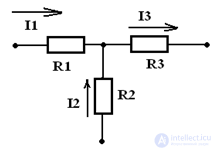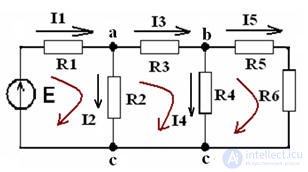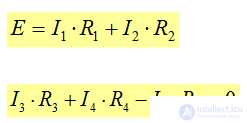Ohm's law - current strength is directly proportional to the applied voltage and inversely proportional to the resistance of the conductor.

Generalized Ohm's law for the active branch:

Rule: EMF and voltage are taken with a “+” sign, if their directions coincide with the direction of the current, and with a “-” sign, if not.
Kirchhoff's laws 1st law: the algebraic sum of the currents of the branches converging in one node is zero. Rule: the current flowing into the node is taken with a "+" and flowing with a "-".
Σ Ii = 0, for example:
I1 + I2 - I3 = 0

2nd law: the algebraic sum of voltages on the resistive elements of a closed active circuit macn (Fig. 1) is equal to the algebraic sum of the emf included in this circuit.
ΣRi • Ii = ΣEi
Example: Let's make an equation according to the 2nd Kirchhoff's law for 1 circuit and for 2 circuit, Fig. 1:


the algebraic sum of the voltages of all sections of the closed passive loop abcd (Fig. 1) is 0.
ΣUi = 0
The rule is: if the emf and current have the same direction as the circuit bypass direction, then they are taken from “+”, if not, then from “-”.
Joule-Lenz law Power source e. energy is defined as the product of current and voltage:
Pist = U • J or Rist = E • I
The power of the receiver is defined as the product of the square of the current and the resistance of the branch:
Rpr = I² • R





Comments
To leave a comment
Electrical Engineering, Circuit design
Terms: Electrical Engineering, Circuit design